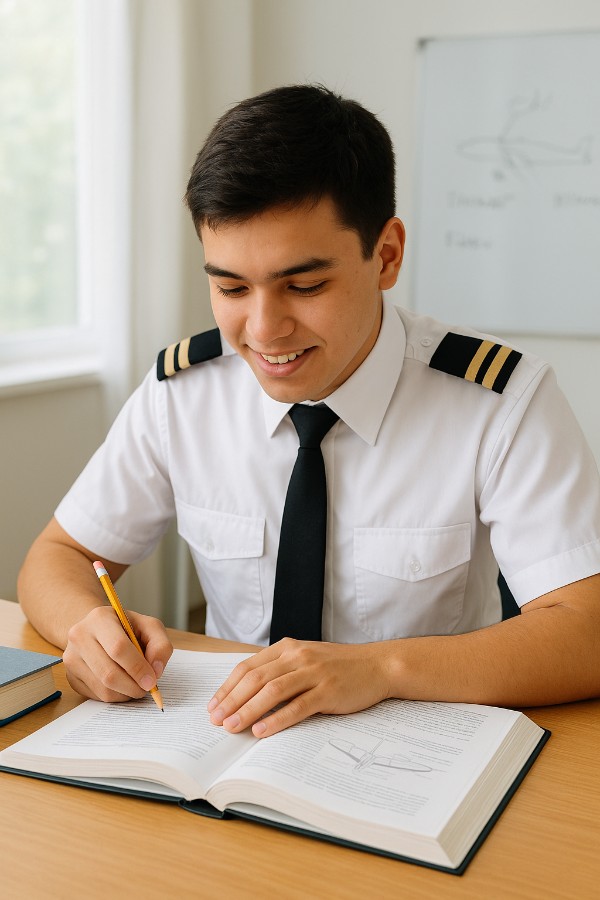How to Survive Accelerated Flight Training in the U.S. as a Non-Native English Speaker
Accelerated flight training programs in the United States are designed to help you earn your pilot certificate quickly. These programs move fast, often packing months of training into just a few weeks. For non-native English speakers, this can feel overwhelming. But with the right preparation, tools, and mindset, you can succeed. This guide will show you step by step how to survive—and thrive—during accelerated training.
1. Familiarize Yourself with the Books
 You're going to study and like it!
You're going to study and like it!One of the most important steps you can take before training even starts is to get to know the books and study materials. Flight schools often use standard FAA materials like the Pilot’s Handbook of Aeronautical Knowledge and the Airplane Flying Handbook. These books are free online in PDF format, and you can also buy printed copies.
If English is not your first language, don’t wait until class begins to open these books. Start early. Read slowly, underline new words, and use a dictionary or translation tool when you need to. The more familiar you are with the material before training, the easier it will be to keep up once the lessons start moving quickly.
Tip: Write down aviation vocabulary in a notebook. Words like “aileron,” “stall,” “altimeter,” or “yaw” are easier to understand if you practice them ahead of time.
Find many of the FAA handbooks you
will have to know on their website here.
2. Study Beforehand
Accelerated flight training does not give you time to sit back and “catch up later.” Every day builds on the day before. If you fall behind, it can be very difficult to recover. That is why studying beforehand is critical.
Before you arrive in the U.S., you should:
- Review basic aerodynamics and flight theory.
- Practice weather terms and symbols used in aviation.
- Learn common ATC (Air Traffic Control) phrases.
- Memorize checklists for preflight and basic maneuvers.
Even if you don’t understand everything yet, simply being familiar with these subjects will give you a big advantage. Think of it as “warming up” before the real training begins.
3. Use a Flight Simulator
A flight simulator is one of the best tools for a student pilot, especially for those who are not native English speakers. Today, you don’t need expensive equipment—a computer and programs like Microsoft Flight Simulator or X-Plane can help you practice.
You can use a simulator to:
- Learn cockpit layouts.
- Practice using radios and hearing ATC instructions.
- Rehearse basic maneuvers like climbs, turns, and descents.
- Build confidence before flying in the real airplane.
The more you practice at home, the more natural everything will feel in the aircraft. This also reduces the stress of trying to translate instructions while flying.
4. Sit In on Other Students’ Lessons
One secret to surviving accelerated flight training is to learn not only from your own lessons but also from others. Ask your school if you can sit in on other students’ ground school lessons and flight briefings.
By observing another student’s lesson:
- You hear the same material explained more than once.
- You can focus on listening without the pressure of being tested.
- You become familiar with how instructors speak and explain in English.
If possible, also sit in the backseat of training flights (if the school allows). Watching another student fly helps you understand the flow of the lesson without the pressure of flying yourself. This is especially helpful for non-native English speakers because you can practice listening to radio calls and instructor feedback.
5. Don’t Be Afraid to Ask for Help
Many students are embarrassed to ask for help, especially with English. But flight training is no place to stay silent. If you don’t understand something, it’s better to ask right away than to guess. Flying an airplane is serious, and safety depends on clear communication.
Remember: even native English speakers ask questions during training. Instructors expect it. Be honest with your teachers about your English level, and let them know if you need extra explanation.
6. Get Support for English and Aviation Lessons
If you find that the combination of English and flight training is too overwhelming, don’t give up. Many students face this challenge, and the solution is to get extra support. Working with an aviation English tutor can make a big difference.
A good tutor can help you practice:
- Aviation vocabulary and radio phraseology.
- Listening to ATC recordings and responding correctly.
- Understanding your textbooks more quickly.
- Feeling more confident in lessons.
If you need help with English or flight lessons, you can contact me directly through my website. I work with non-native English speakers just like you and can help you prepare before you arrive, or support you during training.
Final Thoughts
Accelerated flight training in the U.S. is not easy. The pace is fast, and for non-native English speakers, it can feel like trying to drink water from a fire hose. But with the right preparation, you can do it.
Start by familiarizing yourself with the books, study as much as possible beforehand, use a flight simulator to practice, and learn from other students’ lessons. Don’t be afraid to ask for help, and if you need extra support with English, reach out for tutoring.
Many international students have gone through the same challenges and have succeeded. With preparation and determination, you can too. The skies are waiting for you.
More information on
accelerated Flight training
Accelerated Flight Training Private Pilot
Find out more on what you need to start as a private pilot to succeed.
Accelerated Flight Training Programs
The pros and cons of these types of programs for you.